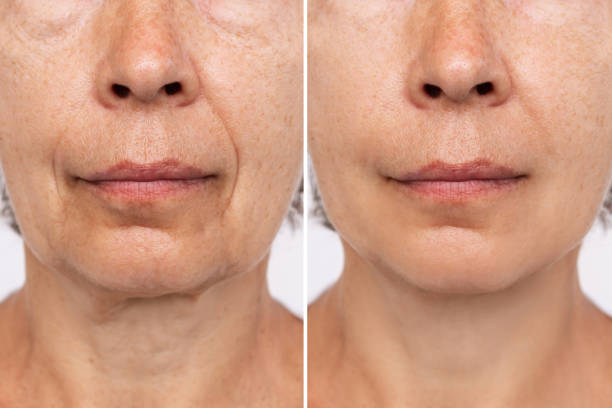The riskiest areas for filler injections depend on the type of filler and the individual’s anatomy. However, some common areas where filler injections can carry higher risks include:
- Under the Eyes: Injecting filler too close to the delicate under-eye area can potentially cause lumpiness, swelling, or even damage to blood vessels. It requires a skilled practitioner.
- Lips: Lip fillers can lead to overfilling, asymmetry, or uneven results if not administered carefully. The lips are a highly visible and sensitive area.
- Nose (Non-surgical Rhinoplasty): Using filler to reshape the nose can be risky as it requires precision to avoid complications like vascular compromise or skin necrosis.
- Temple Area: Filling the temples incorrectly can lead to visible bumps or overcorrection, which can be difficult to correct.
- Jawline and Chin: Fillers in the jawline and chin can affect the shape of the face, so it’s important to have an experienced practitioner to avoid unnatural results.
- Non-medical Spas or Untrained Providers: Going to inexperienced or untrained providers in non-medical spa settings can pose risks due to improper technique or hygiene.
- Injection into Blood Vessels: Injecting filler into a blood vessel can cause serious complications like tissue necrosis. Practitioners should be well-versed in vascular anatomy.
It’s essential to choose a qualified and experienced medical professional for any filler treatment to minimize risks and ensure safe and natural-looking results. Always consult with a board-certified dermatologist or plastic surgeon for such procedures.
Where should you not inject filler?
There are certain areas where filler injections should generally be avoided due to the potential for increased risks and complications. These areas include:
- Inside Blood Vessels (Intravascular Injection): Injecting filler directly into a blood vessel can lead to serious complications, such as tissue necrosis (cell death), blindness, or stroke. It is crucial for the practitioner to be well-versed in vascular anatomy to prevent accidental intravascular injection.
- Infection Sites: Injecting filler into areas with active infections or skin conditions can worsen the condition and increase the risk of complications. Filler should only be administered to healthy skin.
- Areas with Nerves and Sensory Organs: Injection near nerves or sensory organs, such as the eyes, can lead to nerve damage, pain, or altered sensation. Extreme caution is required in these areas.
- Scar Tissue: Filling over or near scar tissue can result in irregular or unpredictable outcomes, as the filler may not distribute evenly. Scarring can also be aggravated.
- Areas with Preexisting Lumps or Bumps: Injecting filler into areas with preexisting lumps or bumps can make these irregularities more noticeable and may not provide a smooth result.
- Inside the Nose (Nasal Cavity): Filling inside the nasal cavity should be avoided to prevent potential breathing difficulties or damage to the nasal structures.
- Bony Areas with Thin Skin: Injecting filler into bony areas with thin skin, such as the forehead or temples, can lead to visible lumps or an unnatural appearance. Careful assessment is required.
- Excessive Amounts: Overfilling or injecting excessive amounts of filler in any area can result in an unnatural or distorted appearance. It’s important to prioritize a natural look.
- Non-Medical Settings: Avoid receiving filler injections in non-medical settings or from unlicensed individuals, as this increases the risk of improper technique, infection, or complications.
- Areas Not Approved by Regulatory Authorities: Some filler products are approved for specific areas of the face and body. Using them in unapproved areas can lead to unforeseen risks.
It’s essential to consult with a qualified and experienced medical professional, such as a board-certified dermatologist or plastic surgeon, for filler treatments. They can assess your individual needs, provide guidance on suitable areas for filler, and ensure a safe and natural-looking outcome while minimizing risks. Always prioritize safety and choose a reputable practitioner.

Is cheek filler high risk?
Cheek filler injections are generally considered a safe and effective cosmetic procedure when performed by a skilled and experienced medical professional. However, like any medical treatment, there are risks associated with cheek filler injections, and the level of risk can vary depending on several factors:
- Practitioner’s Skill: The skill and experience of the practitioner performing the procedure play a crucial role in minimizing risks. A board-certified dermatologist or plastic surgeon with expertise in dermal fillers is more likely to provide safe and satisfactory results.
- Product Used: The type of filler used can impact the safety of the procedure. Hyaluronic acid-based fillers, which are commonly used for cheek augmentation, are considered safe and reversible. However, other types of fillers may carry different risks.
- Technique: Proper injection technique is essential to ensure even distribution of the filler and to avoid complications such as lumps, overcorrection, or asymmetry.
- Anatomy: A thorough understanding of facial anatomy is crucial for avoiding complications when injecting cheek fillers. Practitioners must be aware of the location of blood vessels and nerves to prevent accidental injection into these areas.
- Patient Factors: Individual factors, such as the patient’s medical history, skin condition, and any medications they are taking, can influence the safety of the procedure.
- Amount of Filler: Injecting excessive amounts of filler in the cheeks can result in an unnatural appearance and increase the risk of complications.
- Aftercare: Proper post-treatment care, including avoiding excessive pressure or massage on the treated area and following any post-procedure instructions provided by the practitioner, is important for minimizing risks.
- Possible Complications: While uncommon, potential complications of cheek filler injections may include bruising, swelling, redness, pain, infection, asymmetry, or lumps. In extremely rare cases, vascular complications can occur.
It’s important for individuals considering cheek filler injections to research and choose a reputable and qualified practitioner, have a thorough consultation to discuss their goals and potential risks, and follow all pre- and post-treatment instructions carefully. While cheek filler injections are generally considered safe, it’s essential to be aware of the potential risks and benefits and make an informed decision in consultation with a medical professional.
